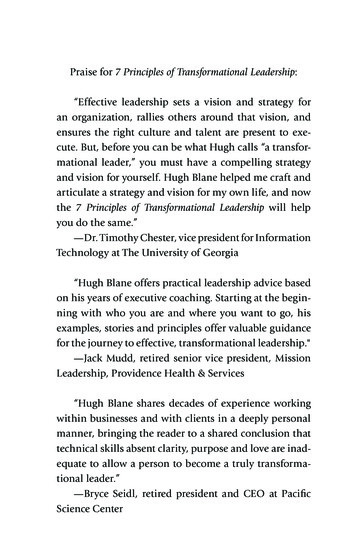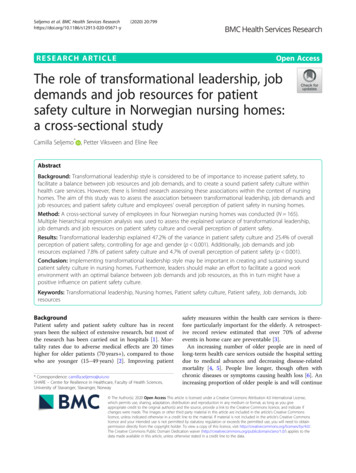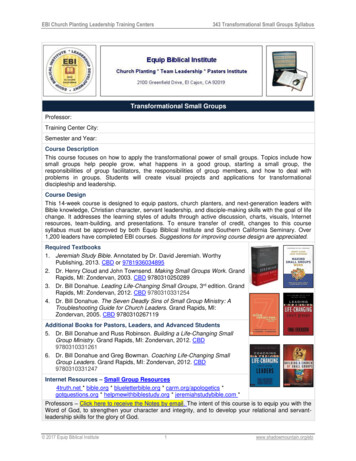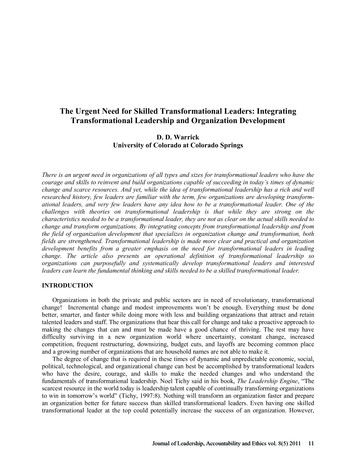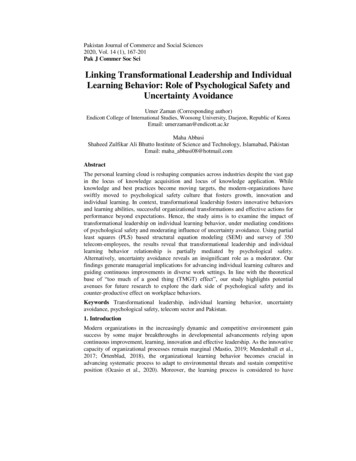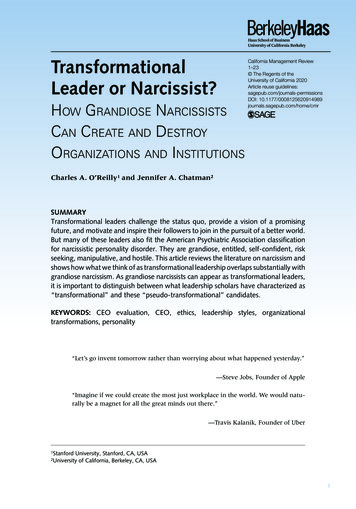
Transcription
XXX10.1177/0008125620914989CALIFORNIA MANAGEMENT REVIEWTransformational Leader or Narcissist? How Grandiose Narcissists Can Create and Destroy Organizations and ader or Narcissist?How Grandiose NarcissistsCan Create and DestroyOrganizations and InstitutionsCalifornia Management Review 1 –23 The Regents of theUniversity of California 2020Article reuse /doi.org/10.1177/0008125620914989DOI: cmrCharles A. O’Reilly1 and Jennifer A. Chatman2SUMMARYTransformational leaders challenge the status quo, provide a vision of a promisingfuture, and motivate and inspire their followers to join in the pursuit of a better world.But many of these leaders also fit the American Psychiatric Association classificationfor narcissistic personality disorder. They are grandiose, entitled, self-confident, riskseeking, manipulative, and hostile. This article reviews the literature on narcissism andshows how what we think of as transformational leadership overlaps substantially withgrandiose narcissism. As grandiose narcissists can appear as transformational leaders,it is important to distinguish between what leadership scholars have characterized as“transformational” and these “pseudo-transformational” candidates.Keywords: CEO evaluation, CEO, ethics, leadership styles, organizationaltransformations, personality“Let’s go invent tomorrow rather than worrying about what happened yesterday.”—Steve Jobs, Founder of Apple“Imagine if we could create the most just workplace in the world. We would naturally be a magnet for all the great minds out there.”—Travis Kalanik, Founder of Uber1StanfordUniversity, Stanford, CA, USAof California, Berkeley, CA, USA2University1
2CALIFORNIA MANAGEMENT REVIEW 00(0)“I don’t want to make an incremental change in some technology in my life. Iwant to create a whole new technology, and one that is aimed at helping humanity at all levels regardless of geography or ethnicity or age or gender.”—Elizabeth Holmes, Founder of Theranos“We always wanted to create a business that makes a difference in the world.”—Adam Neuman, Founder of WeWork“Together we will make America proud again. We will make America safe again.And, yes, together, we will make America great again.”—Donald Trump, 45th President of the United StatesWhat’s common among these leaders? First, most would agree that theyhave been visionaries. Each articulated a vision—for a product, service, technology, or a movement—that attracted fervent followers and, each in their ownway, had the potential to change the world. Each articulated a compelling visionfor what the world could look like. In the parlance of modern leadership, theywere transformational leaders: bold, self-confident, risk-taking, charming, strongwilled, and able to attract legions of others to their cause.1What is also common across these five leaders is that they also likely meetthe American Psychiatric Association’s Diagnostic and Statistical Manual of MentalDisorders (the DSM-5) criteria for narcissistic personality disorder (Figure 1)—acondition in which people have an inflated sense of their own importance, a viewthat they are entitled—not subject to the normal rules and norms—and superiorto others, a need for admiration, extreme self-confidence, a willingness to exploitothers for their own ends, and showing hostility toward those who challengethem. Because of their extraversion, self-promotion, and willingness to take risks,narcissists (and visionaries) often seek out and rise to positions of prominence inorganizations.2 But narcissists are also abusive leaders, quick to derogate othersand to create cultures that are lower in integrity and teamwork.3 Those we oftenadmire as transformational leaders may also be narcissists. What we see initiallyas visionary, self-confident, strong-willed, charming, and challenging may—in theextreme—be grandiose, entitled, arrogant, exploitative, impulsive, and aggressive. A failure to understand these differences can be dangerous, putting peopleand institutions at risk. Figure 2 illustrates the interplay between narcissism andtransformational leadership.What is the difference between a transformational leader and a narcissist?Clearly transformational leaders can be critically important in transforming industries and societies. These leaders motivate followers not by the social exchangeand mutual benefits that transactional leaders provide but by raising the consciousness of their followers and inspiring them to pursue an energizing and unifying higher cause. The motivation is not self-interest but the pursuit of a collective
Transformational Leader or Narcissist? How Grandiose Narcissists Can Create and DestroyFigure 1. The Diagnostic and Statistical Manual of Mental Disorders Definition ofNarcissistic Personality Disorder—(DSM V—301.81).Source: Diagnostic and Statistical Manual of Mental Disorders, DSM-5 (Arlington, VA: American PsychiatricAssociation, 2013).Figure 2. The impact of narcissism and transformational leadership on organizations.goal.4 Transformational leaders create meaning that enables followers to identifywith these leaders and internalize their vision.5The concept of transformational leadership has been central to the study ofleadership for the past 40 years—with debates about whether transformationalleaders can include those with malign intent, like Hitler, Stalin, or Osama binLaden—sometimes referred to as pseudo-transformational leaders.6 The most distinctive characteristics of transformational leaders are that they provide a clearvision of the future (often challenging the status quo), mobilize support throughtheir words and actions (and are often charismatic), and inspire their followers totranscend self-interest to pursue a collective goal.7 Unlike transactional leaderswho maintain the status quo, transformational leaders inspire and motivate their3
4CALIFORNIA MANAGEMENT REVIEW 00(0)followers to innovate and change, either for good or for ill. In this sense, narcissists can also be transformational leaders. What is tricky is that transformationalleaders can direct their followers to pursue good collective goals, but, because oftheir persuasiveness and charisma, they also have the capacity to channel followers’ efforts toward less savory goals.8 Like transformational leaders, narcissists candemonstrate the vision and charisma that moves people to action, but their goals(which are often masked) are ultimately self-serving and lacking in integrity.9Positive transformational leaders—such as Jeff Bezos, founder of Amazon,and Reed Hastings, founder of Netflix—have pioneered new industries. Others—such as Lou Gerstner, former CEO of IBM, and Alan Mulally, former CEO of Ford—have saved iconic firms from extinction. Still other transformational leaders haveled social movements that have changed society—think of Nelson Mandela, MartinLuther King, or Susan B. Anthony. Each of these leaders left an enduring impactby not only inspiring change, but by leaving their organization or movement in acondition that allowed subsequent leaders to further improve it.But transformational leaders, especially those who are narcissistic, can alsoembody a dark side, mobilizing followers to pursue goals that are dangerous. Afailure to understand these differences can put organizations at risk. For example,Elizabeth Holmes promised to revolutionize health care. At one point her company, Theranos, had 800 employees, was valued at 9 billion and had attractedsophisticated investors including Tim Draper and Larry Ellison. She was subsequently found to have engaged in a massive deception, resulting in the loss of the 700 million invested in the firm. She has been criminally charged with fraud.10Similarly, Adam Neuman founded WeWork with a promise “to create a businessthat makes a difference in the world” and claimed that his descendants would berunning WeWork in 300 years. He aspired to live forever, be leader of the world,and be the world’s first trillionaire.11 Instead, the company lost 90 percent of itsvalue, going from a 47 billion valuation to near bankruptcy, even as he walkedaway with 1.7 billion.12 Travis Kalanik, co-founder of Uber, claimed “to believein creating a workplace where a deep sense of justice underpins everything wedo” but ended up creating a company that was characterized by sexual harassment and routinely violated laws. The company is currently under five investigations for criminal behavior.13Steve Jobs is often cited as a prototypical transformational leader, but hisbiographer, Walter Isaacson, described how Jobs humiliated others, was impulsive, took credit for others’ work, lied (“the reality distortion field”), and believedthat the rules did not apply to him—even routinely parking in handicapped parking spots.14 Job’s girlfriend, after reading about the Narcissistic PersonalityDisorder, decided that the criteria applied perfectly to him. A book by 27 psychiatrists and mental health professionals analyzing Donald Trump’s behavior concluded that his grandiosity, sense of entitlement, impulsiveness, willingness toexploit others, lack of empathy, hostility, and willingness to ignore embarrassingfacts were so extreme that they could be characterized as “malignant narcissism.”15 The Washington Post reported that over 1,055 days in office, Trump has
Transformational Leader or Narcissist? How Grandiose Narcissists Can Create and Destroymade more than 15,000 false or misleading claims.16 And, despite filing for bankruptcy six times and being sued more than 4000 times, Trump publicly claimedthat “I was successful at everything I ever did.”17Understanding how and why narcissists may be seen as transformationalleaders is important for the health and governance of organizations. Here, wereview the growing literature on narcissistic leadership, illustrate the ways thatnarcissistic leaders influence organizations, discuss why narcissistic leaders can beso appealing, identify ways to distinguish between genuine transformational leaders and their narcissistic imitators, and offer ideas for avoiding narcissistic leaders.NarcissismNarcissism is a relatively stable individual difference characterized bygrandiosity, self-confidence, risk-taking, impulsiveness, an inflated view one’sabilities, a sense of entitlement, a willingness to use others to achieve one’s ownself-interests, and hostility when challenged. It can be assessed through a person’s behavior and thought of as a spectrum with both very high and very lowlevels being potentially problematic.18 For example, if a person has no vision,lacks self-confidence, and abhors risks, that person is unlikely to be an effectiveleader. In contrast, when a person is overconfident, believes that they are special, and ignores the advice of others, that person can be dangerous—makingimpulsive decisions, taking excessive risks, and pursuing their own needs at theexpense of others. In his book, The Narcissist Next Door, Jeffrey Kluger capturesthis observing that: “A little narcissism can be a good thing in many jobs: a lot ofnarcissism is a bad thing in almost all jobs.”19Although an old construct in psychology, more recent research has identified two primary types of narcissism.20 One stream, emerging from a more clinicaltradition, has focused on what is referred to as vulnerable or covert narcissism,which is characterized by anxiety, a fragile self-concept, high levels of neuroticism, and low self-esteem.21 This form of narcissism, sometimes referred to aspathological or maladaptive, emphasizes a defensive self-presentation stemmingfrom low self-esteem and a more introverted nature. The underlying theory isthat the unrealistic sense of superiority and self-confident presentation masks anunderlying insecurity and low self-esteem.In contrast, recent research has focused on grandiose narcissism—a moreassertive and extraverted form characterized by high self-esteem, a sense of personal superiority and entitlement, overconfidence, grandiosity, a willingness toexploit others for self-gain, and hostility and aggression when challenged.22 Unlikethe maladaptive form of narcissism, grandiose narcissists have high self-esteemand believe that they are genuinely better and more competent than others. Theyare often characterized by high levels of extraversion (sociable and action oriented) and low levels of agreeableness (selfish and low social empathy). Althoughthere is some overlap between the two types of narcissism, the preponderance ofevidence suggests that they are distinct constructs. Men have also been shown to5
6CALIFORNIA MANAGEMENT REVIEW 00(0)have a higher incidence of narcissism than women.23 Our focus here is on grandiose narcissism, the type most likely to emerge as leaders in organizations.24Grandiose NarcissismThe past decade has seen an outpouring of research on grandiose narcissism. Figure 3 provides a roadmap summarizing that research. Numerous studieshave shown how the defining characteristics of grandiose narcissists predisposethem to seek out and obtain leadership positions as a way to demonstrate theirsuperiority. These attributes make them seem leader-like. Once in power, narcissistic leaders pursue their own interests, often taking out-sized risks, manipulating others, and behaving in unethical ways. Even worse, when a narcissisticleader achieves success their self-confidence increases, they feel justified in ignoring the advice of others, and they take even more risks. Success chips away attheir hold on reality. In the following section, we illustrate how this occurs.GrandiosityGrandiose narcissists can be characterized in several ways. First, they aregrandiose, convinced that they are special and better than others—especiallymore creative, competent, and intelligent. They often believe that their ideas aresuperior and that, as a result, they—uniquely—can solve intractable problemsand, in effect, change the world. For example, Donald Trump, in accepting theRepublican nomination in 2016 said: “Nobody knows the system better thanme, which is why I alone can fix it.” In talking about trade between the U.S.and China on August 21, 2019, he said unambiguously, “I am the chosen one—somebody had to do it so I’m taking on China on trade and, you know what, weare winning.”Because of their belief in their own superiority, grandiose narcissists alsofeel that they should be recognized as superior, seeing themselves as superior onagentic, “superhero-like traits such as intelligence, dominance, and emotional stability.”25 Donald Trump even asserted his superiority in humility, stating on 60Minutes in July, 2017, that: “I’m much more humble than you would ever understand.” Importantly, the research clearly shows that these feelings are not matchedby objective levels of intelligence or competence.26 For example, in a series ofstudies of decision making, leader grandiosity was associated with greater risktaking but not better performance.27 Other studies have shown that grandiosenarcissists rate themselves as better leaders and more effective than their peers—but more objective ratings of performance by superiors or peers fail to validatethese self-perceptions. Indeed, grandiose narcissists are often rated as less competent than their non-narcissistic counterparts.28Excessively Self-Confident and Risk SeekingNarcissists are also highly self-confident and often seen as overconfident.29And, because they believe that they are smarter than others and that their
Transformational Leader or Narcissist? How Grandiose Narcissists Can Create and DestroyFigure 3. The organizations effects of narcissistic leaders.judgments are more likely to be uniquely insightful and correct, they are oftenseen by others as more effective, especially upon first impression or when otherscannot observe their actual performance.30 For example, in a series of studies,subjects were shown pictures of people who varied in their degrees of narcissism.Observers saw those higher in narcissism as having higher self-esteem and asmore likable.31 Interestingly, over time as people come to know them, grandiosenarcissists become less likable and seen as less competent.32 This ability to makepositive first impressions provides an essential insight into the mystery behindwhy narcissists are able to access high-status positions. Impressing evaluators injob interviews by promoting their accomplishments in confident, charming, andcharismatic ways enables narcissists to have a key gateway, and explains whynarcissists are disproportionally represented in the highest level roles such asCEO and even as President of the United States.33Grandiose narcissists’ negative attributes and impact typically only emergeover time.34 Not only do views of narcissists become more negative over time, buttheir excessive self-confidence makes them unwilling to take advice and listen toothers, instead relying on their own judgment.35 For example, narcissists’ overconfidence leads them to bet more and to lose more than those who were lessnarcissistic.36 Narcissists have also been found to not listen to experts, seeingthemselves as more competent. Their overconfidence, as well as their view thatno one will be as attentive as they require in promoting their interests, also makesthem mistrustful of others. Steve Jobs had a treatable form of pancreatic cancerbut ignored the advice of his doctors, preferring instead to self-diagnose until itwas too late. Donald Trump routinely dismisses the advice of legal, diplomatic,and military experts. Their self-confidence also leads narcissists to have less trustin others, further diminishing their willingness to listen to words of caution.37Furthermore, because of their excessive self-confidence and sense of entitlement, grandiose narcissists are also risk-seeking. They believe that they are7
8CALIFORNIA MANAGEMENT REVIEW 00(0)uniquely right and look for opportunities to demonstrate their superiority. Theyare more sensitive to the potential upside of a bet while ignoring the downside;that is, they see the opportunity for glory as outweighing any potential of a loss.38In a study of stock market investing, narcissists picked more volatile stocks thandid non-narcissists—and lost more.39 Their overconfidence in their own judgmentand their belief that they are not subject to the same rules and norms means thatthey often bet on long shots. For example, when the odds of losing increase, nonnarcissists predictably are less likely to take a bet while narcissists increase theprobability of taking the same bet.40 Other studies have shown that narcissistsinvest in more risky ventures and lose more.41 This propensity to take risks coupled with their self-confidence and unwillingness to listen to experts also makesthem more impulsive, taking risks without careful due diligence, and imperilingthe organizations they lead.42EntitledAs narcissists believe that they are better and more competent than others, they often feel that they deserve special treatment and that the rules do notapply to them. They are motivated by their own need for self-enhancement,which leads them to self-promote and violate social conventions.43 They willeven declare their superiority over others, typically by overclaiming credit forothers’ accomplishments, often at the cost of those relationships.44 In one study,narcissists continued to overclaim (claiming they knew more than others) evenwhen they knew the claims were false, a trait seen in Elizabeth Holmes, DonaldTrump, and Steve Jobs.45 For example, narcissistic CEOs received more salary,bonus, and stock options than did less narcissistic CEOs. These narcissistic CEOsalso had larger discrepancies between their compensation and the compensationof their top executive team.46Manipulative and Low IntegrityNarcissists are manipulative and lack integrity. They have lower levels ofempathy than do non-narcissists and are less prone to feeling guilt.47 This meansthat in their efforts to garner recognition, they are willing to “act in their ownbest interest, putting the needs and interests of others at risk.”48 Narcissists alsohave been found to have lower levels of integrity and behave less ethically.49They are significantly more likely to lie, cheat, and steal for their own benefit.50People who were more narcissistic were also more likely to engage in whitecollar crime.51 In organizations, grandiose narcissists have been found to be morelikely to engage in litigation and fraud.52 As leaders, narcissists are more likelyto create organizational cultures that magnifying the negative consequences oftheir own personal behavior.53Hostility and AggressionAs grandiose narcissists believe that they are special and superior to otherpeople, they often feel that they are not receiving the admiration and credit theydeserve. They are hypervigilant about threats to their ego so that any lack of
Transformational Leader or Narcissist? How Grandiose Narcissists Can Create and Destroyadmiration or criticism provokes them. These feelings are commonly expressedthrough hostility and aggression.54 They routinely blame others for their mistakes.55 For example, when narcissists feel that they are not being sufficientlyadmired, they are less likely to apologize, more likely to lash out, and retaliateagainst those who are critical, hold grudges, feel distrustful of others, and, mayeven resort to violence.56 For instance, in a review of 20 studies with objectivemeasures of aggression and violence, grandiose narcissists were as much as 11times more likely to engage in violent acts as were non-narcissists.57 Narcissismhas also been found to be related to aggressive driving, sexual harassment, andsexually coercive behavior.58Consequences of Grandiose Narcissists for OrganizationsGiven this profile of grandiose narcissists, what are the likely consequenceswhen such people assume leadership roles in organizations? As illustrated inFigure 3, several disturbing trends are likely. First, as they are overconfident andsocially prominent, grandiose narcissists seek out leadership positions to demonstrate their superiority and garner others’ admiration. “Leadership positionsare a natural venue for achieving (their) needs for self-enhancement and superiority.”59 “Narcissists are certain that the world would be a much better place ifthey ruled it.”60 A wealth of research supports these observations and shows thatgrandiose narcissists actively seek out leadership positions and emerge as leaders.Their apparent confidence, extraversion, and willingness to challenge others fitthe stereotype of a prototypical leader, even if their performance is objectivelyno better.61 Furthermore, they often overclaim credit for their contributions,and, given the difficulty of identifying credit in group and organizational settings,deriving accurate assessments of narcissists’ actual contributions can be difficult.Not only do grandiose narcissists seek out leadership roles, they are adeptat self-promotion.62 Owing to this, they often achieve higher ranks and earnmore.63 And, as they lack feelings of guilt and have a lower need for intimacy,they are more willing to manipulate others, making them effective at organizational politics. As they want control and are susceptible to flattery, they tend torecruit and promote others who may be less experienced or competent but whowill be loyal, often valuing loyalty over expertise. “Narcissistic CEOs reward thosewho reinforce their narcissism and punish those who do not.”64 Perhaps moreimportantly, research also shows that subordinates working for narcissistic leadersare more frustrated and stressed, as well as are less satisfied and less committed totheir employing organization. A series of studies showed that grandiose narcissistswere less generous and less willing to help others than did non-narcissists.65 Worseyet, employees working for narcissistic leaders are more likely to withhold information, engage in shirking, absenteeism, and even sabotage.66 There are estimatesthat these counter-productive behaviors may cost firms more than 20 billionannually.67When connecting narcissistic leadership to firm performance, the researchhas been inconclusive. In one study of technology CEOs, there was no associationbetween CEO narcissism and firm performance. In other studies, consistent with9
10CALIFORNIA MANAGEMENT REVIEW 00(0)grandiosity and risk seeking, it was the case that firms with narcissistic CEOs hadgreater volatility in their earnings and that these companies tended to make moreacquisitions.68 Still other studies also found higher volatility of earnings with firmswith narcissistic CEOs.69 Interestingly, firms headed by narcissistic CEOs bothengage in more acquisitions and are likely to overpay for them. These firms arealso more likely to pursue new technologies and to pursue internationalization asa strategy—all consistent with a leader who is confident and risk-seeking—butnot necessarily value creating.70 Firms led by narcissistic CEOs engage moreactively in corporate social responsibility efforts instrumentally as a way toenhance their reputation.71 Two studies illustrate how narcissistic CEOs’ riskseeking behavior can lead to increased returns when the market is going up, butsuffer larger losses when the market turns down.72 They overinvest in good timesand underinvest in the bad.73 Just as a gambler can go on a winning streak, narcissistic CEOs can appear brilliant for a while—but suffer in the end.A series of studies performed by finance and accounting researchers provide a more fine-grained look at the downside of narcissistic CEOs. These studiesshow that more narcissistic CEOs are more optimistic in earnings calls, are morelikely to engage in the manipulation of earnings, increase their firm’s audit risks,and engage in fraud.74 Narcissistic CEOs have also been shown to pressure theirchief financial officers (CFOs) to engage in financial misreporting and end up incostly litigation.75 These actions often lead to serious lapses in ethical conduct andput their firms at risk, as seen in the current situations at Theranos, Uber, andWeWork as well as in previous situations at firms such as Tyco, Enron, andWorldCom.Narcissistic leaders exist in the public sector as well as the private. Severalstudies have been undertaken exploring the role of narcissism among U.S.Presidents. By careful coding of biographies and Presidential speeches, researchershave found that narcissism is associated with increased perceptions of charisma,higher levels of psychopathy, and more effective legislation but also more ethicalbreaches and a higher probability of impeachment.76 More recent studies of ourcurrent president, Donald J. Trump, have confirmed that he is very high on narcissism and that many voters saw him as charismatic and voted for him becauseof this.77 In a study of narcissism among celebrities, reality TV stars were found tobe the most narcissistic.78Why Do People Follow Narcissists?Given the evidence for the potential destructive nature of narcissisticleaders, why would anyone choose to follow them? Several factors make themattractive. First, from a distance, narcissists are often difficult to identify. Theyappear to be casual observers as prototypical leaders—bold, confident, competent, and offering a promise of a better future. They are often charming, humorous, and can initially appear humble. In his biography, Isaacson reports thatSteve Jobs was particularly adroit at feigning modesty. Narcissists can also be
Transformational Leader or Narcissist? How Grandiose Narcissists Can Create and Destroyeffective at managing upward, flattering their superiors, taking credit for theaccomplishments of their juniors, and blaming their failures on others—and feeling no guilt while doing this. Research has shown that while narcissists may lackempathy, they are often emotionally insightful, understanding others’ needs andemotions and using these to their advantage.79 At least in the short term, theycan successfully mimic true empathy. Again, Isaacson describes Jobs as able toseduce people at will. It is only over time that there true disposition is revealed—and by then it is often too late.When are Narcissists Most Likely to Emerge as Leaders?Owing to their self-confidence and willingness to go against the grain,narcissists can be particularly attractive in uncertain situations—entrepreneurial ventures, periods of disruption, crisis, or economic upheaval. When a givenstrategy no longer seems to be working and people are anxious, a self-confident,bold self-proclaimed savior can seem attractive.80 This willingness to challengeaccepted practice is an integral part of the definition of a transformational leader,so narcissists often initially present as transformational. Their boldness and selfconfidence can be reassuring among an anxious group of followers. In support ofthis, research has shown that under conditions of uncertainty people are drawnto narcissistic leaders even when they recognize their liabilities.81 A self-assuredand decisive leader with a new vision can provide a sense of psychological safety.These effects are enhanced when narcissistic leaders use symbolism and simplewords to emphasize a collective future and threats from out-groups.82But what about the so-called “bright side” of narcissistic leaders? Are therecircumstances in which a narcissistic leader might have positive effects? First,recall that narcissism is a spectrum with all individuals having some degree of it.Some heightened level of narcissism can encourage an individual to be bold, challenge the status quo, and persist in the face of failure. Entrepreneurs, for example,have been shown to have heightened levels of narcissism that help them persevere—but at very high levels, it also impedes their learning.83 Overall, the evidence
The concept of transformational leadership has been central to the study of leadership for the past 40 years—with debates about whether transformational leaders can include those with malign intent, like Hitler, Stalin, or Osama bin Laden—sometimes referred to as pseudo-transformational leaders. 6 The most dis-


